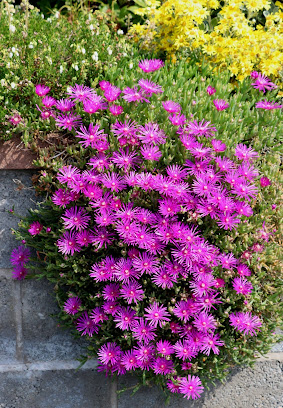 |
| Delosperma cooperii |
Garden plants have had a great boost to growth this year with very favourable weather, at least so far. Although propagation goes on all year round there are many plants we can grow from summer cuttings as growth matures but is still active.
Lamium
White Nancy is a silver coloured attractive ground hugging plant with
shoots that root easily as they hug the soil. Take some of these
shoots with a few roots and pot up as they quickly establish as young
plants. Houttuynia is also propagated by lifting young shoots with
roots on. Border phlox is also propagated from ground hugging
branches that root into the soil as they spread.
Lamium White Nancy
Bearded iris have now finished flowering and any clumps three years old will benefit from digging up, splitting the crowns and replanting into fresh soil. The border pinks may still be flowering, but come easily from cuttings of non flowering shoots about three to four inches long and potted up with potting compost with added grit for extra drainage,
Many
dwarf evergreen azaleas, rhododendrons and camellias can be
propagated both by layering as well as cuttings, but for success you
will need to use ericaceous compost with added grit, sand, or
perlite. Take cuttings from shoots that still look like they have not
finished growing. Size again about three to four inches long. Remove
most of the leaves except a couple near the top and if these are
large cut half of the leaf off. Water in well and keep in a sheltered
light place away from direct sunlight. Most of these cuttings will
root better with the help of some hormone rooting powder.
Hydrangea Charme cuttings
The dwarf japanese azaleas can also be layered. Take a low shoot near the ground and scrape a wee bit of bark off then lower it into the soil while still attached to the parent plant. You will need a peg to keep it in the ground and cover it with soil. It may be at least six months before it is rooted sufficiently to be cut off and either potted up or transplanted to another spot to grow on.
Heathers
will come from cuttings two to three inches long placed in ericaceous
compost with added grit, but keep them away from direct sunlight.
Remove growth from the bottom one or two inches and take the tip out
to encourage it to branch once it roots.
Pink cuttings now rooted
Other plants that root well from mid to late summer as semi ripe cuttings include, Lavender, Cistus, Rosemary, Fuchsia, Senecio, Hydrangea, Euonymus, Lonicera Baggesons Gold and many others.
My two favourite very colourful succulents, the ice plant, Delosperma cooperi and D. nubigenum are easily propagated from short shoots a couple of inches long put direct into the soil. They always root and grow very quickly, but like very well drained soil in a sunny position. Perfect at the top of a south facing wall where they can hang down happily and soon burst into flower.
 |
| Strawberry runners just planted |
Wee
jobs to do this week
Summer strawberries have now finished cropping. Only the perpetual and autumn varieties such as Flamenco continue to fruit. Take this chance to cut off all the old leaves, remove weeds and straw which can all go on the compost heap. The crowns will soon grow fresh young leaves to take the plants through the winter. Once they have made two or three years cropping they should be removed and a new patch planted up from runners. Some varieties produce very few runners after three cropping seasons so take runners from them after two years or buy in fresh plants for autumn planting. Runners are normally spaced a foot apart, but if there is plenty available then plant at six inches apart to give a bigger crop in the first summer.
END

No comments:
Post a Comment